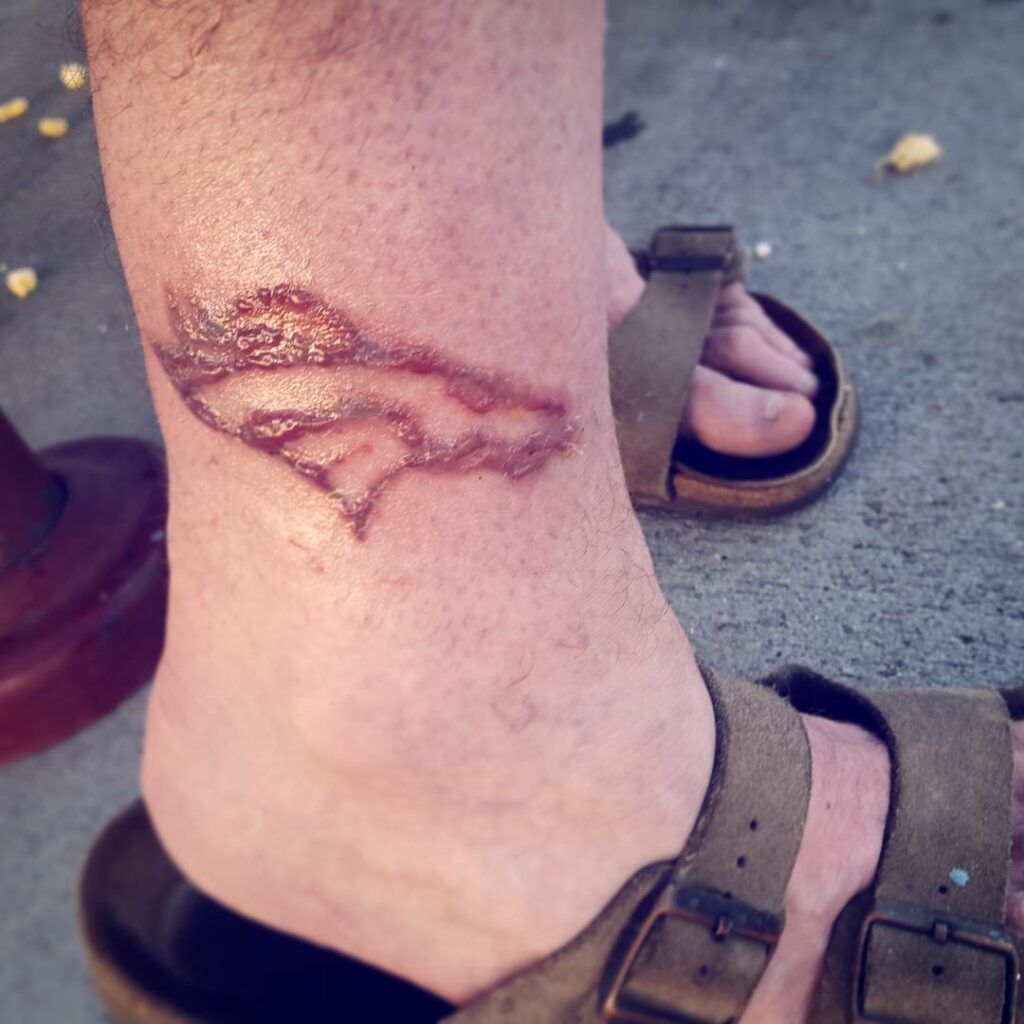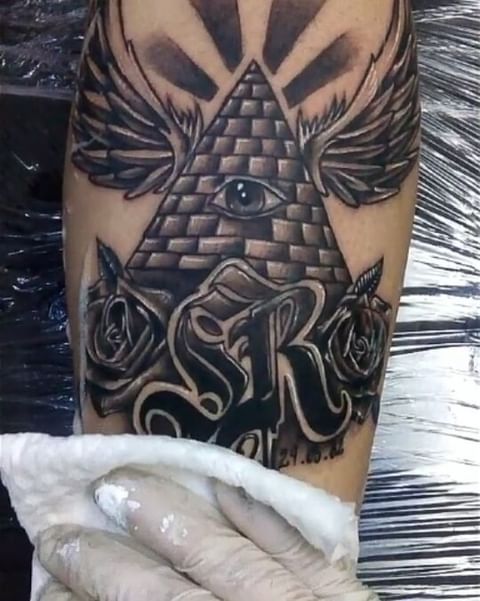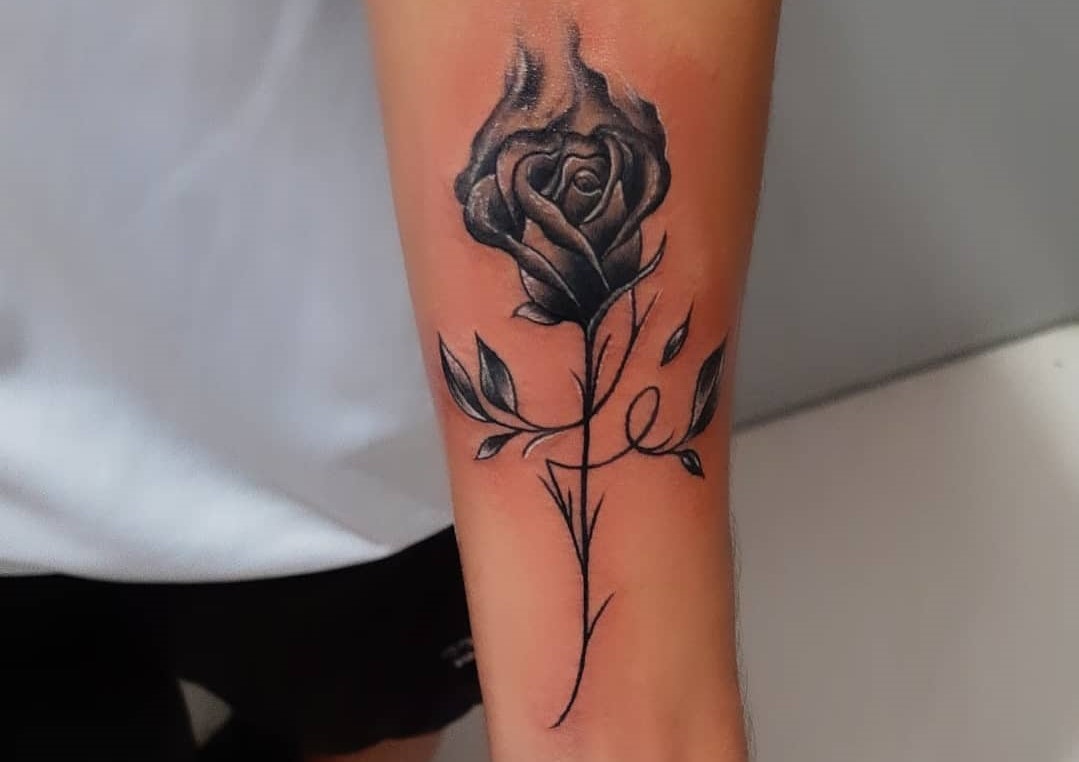Table of Contents
Well, hello there, ink lovers, enthusiasts, and curious souls! It’s Tori, your favorite ink-slinger and maven of all things marked, back with another enlightening dose of tattoo wisdom.
In the ink-filled world of tattooing, I’ve had my fair share of burning questions – quite literally! So, today, we’re diving headfirst into the ‘hot’ topic that’s been buzzing around: “Why Does My New Tattoo Burn?” Ah, the sensation that ranges from a gentle sting to feeling like you’ve sat on a dragon’s tongue. So, buckle up, my skin-art aficionados, as we embark on a skin-deep journey, breaking down the physiology, the cause, and the cure of this flaming query.

In my years in the industry, I’ve come to realize that understanding your body and its response to a new tattoo is just as important as knowing the history of the art itself. Tattooing, an ancient practice, is more than just a pretty piece of art – it’s a symbol, a story, and often, a rite of passage. And with each prick of the needle, we’re becoming part of a rich tradition that dates back thousands of years, from the tribal tattoos of the Polynesian islands to the intricate Irezumi of Japan. Each culture has its influences that have shaped the art of tattooing, and understanding this makes the experience even more enriching.
In this blog post, we’ll take a deep dive into the evolution of tattoo practices, discuss the myriad of factors causing your new tat to burn, and yes, dear readers, dispel some myths along the way (spoiler alert: no, you’re not turning into a dragon). You’ll also learn how to distinguish between a normal burning sensation and when it’s a cry for help, requiring professional attention.
Join me as we walk (or perhaps dance) along the fine line of pain and beauty in the wonderfully vivid realm of tattooing. By the end of this, not only will you be equipped with the knowledge of what’s happening under your skin, but you’ll also have a newfound appreciation for the artistry and the cultural significance of the ink we so lovingly wear.
Here’s to a fun, enlightening journey through the beauty, history, and yes, the occasional burn, of our beloved ink. Stay tuned, stay inked!
Why Does My Tattoo Feel Like It’s on Fire?

Yes, you read it right. Your beautiful new tattoo is technically an open wound, and that fiery sensation is your body’s way of saying, “Hey, I’m working overtime here!” Every stroke of the tattoo needle pierces your skin’s first layer, injecting colored ink into the deeper layer, the dermis. This triggers your body to repair the damaged cells, often resulting in a sensation akin to a sizzling sunburn.
Send In The Platelets
In response, your immune system summons tiny white cell fragments known as platelets to rush to the scene. Much like little superheroes, they weave an interlocking network to scab over the area. This process, however, takes a solid seven to ten days. And until then, you’re stuck with the burn.
Dealing With A Burning Tattoo

So you’ve taken the leap, you’ve got your fresh ink, and now you’re home. It’s time for the all-important step – aftercare. Your tattoo artist should have clued you into an aftercare regimen, and it’s essential to follow it religiously. My personal tip: prepare for the burn.
If your new ink feels like it’s burning the midnight oil, it’s likely due to inflammation. So, how to calm this discomfort? Enter tattoo healing lotion, my personal go-to is After Inked Tattoo Aftercare Lotion. This vegan superstar not only hydrates your tattoo but soothes any itching and irritation. When used from day one, it can help speed up healing and reduce dryness and scabbing.
A simple, old-school remedy can also be quite effective – ice. By elevating the tattooed area and applying a cold compress for 20-30 minutes, you can reduce swelling and inflammation. Be sure to keep the area cold, but not so much that it stings more than the tattoo!
When Burning Becomes A Concern
Occasionally, a new tattoo can become infected, especially if aftercare instructions aren’t followed or if the environment was unsanitary. So, if the burn becomes unbearable or you notice extreme swelling, redness, oozing, or even develop flu-like symptoms, it’s time to call in the professionals. Also, keep an eye out for potential tattoo ink allergies, which can cause a burning sensation, skin rash, intense itching, or irritation.
Cleaning Is Going To Burn

I won’t sugarcoat it, cleaning a fresh tattoo will sting, and unfortunately, there isn’t a workaround. You need to be gentle but thorough. The discomfort should start easing after two-to-three days.
The Cleaning Process
Time to roll up your sleeves. For the first few weeks, do not submerge your new tattoo in water. Instead, hold it under a faucet or take a shower if it’s a larger piece. Use gentle, non-scented soap and build a good lather with your fingertips. Rinse and pat dry with a soft towel. Repeat this process if you’re going for multiple sittings.

Healing from a new tattoo requires patience, but within one to two weeks, the burning, redness, and inflammation should subside. Keep nourishing the area with a tattoo healing lotion to keep the skin well-hydrated and soothed. Remember, your body art is a symbol of your journey, and it’s worth the effort. Stay inked, my friends!
When You Should Worry
t’s a fine line distinguishing between the normal healing process of a tattoo and signs that might indicate a problem. Let’s dive in and explore some pointers to help guide you.
- The burn: A fresh tattoo can sting or burn, much like a sunburn, which is typically a normal part of the healing process. It’s the body’s response to the skin’s puncture and should fade within a few days. If the burning sensation persists for more than a week, intensifies, or is accompanied by increased redness, swelling, or oozing, it might be a signal that professional attention is required.
- The color: Your tattoo will undergo various color changes as it heals. Scabs may darken before they eventually fall off, revealing bright colors beneath. If the tattoo’s color seems overly faded or drastically different from the intended color, or if there’s discoloration in the surrounding skin, you might want to consult a professional.
- The swelling: Some swelling is expected, especially in the initial days. However, if the swelling doesn’t subside after a week, gets worse, or extends beyond the tattooed area, you should seek professional help.
- Fever or flu-like symptoms: These are systemic responses and should be taken seriously. If you experience fever, chills, muscle aches, or feel generally unwell after getting a tattoo, it’s crucial to seek medical attention as it could be a sign of infection.
- Allergic reactions: Though rare, some people can have an allergic reaction to tattoo ink, particularly red ink. If you notice an itchy rash, hives, or severe irritation around the tattooed area, it might indicate an allergic reaction and should be checked by a professional.
Remember, when in doubt, don’t hesitate to reach out to a healthcare professional. Tattooing is a beautiful art form, but it’s also a skin procedure that should be handled with care to ensure your safety and health.
Effective Remedies
Easing the burning sensation of a fresh tattoo is crucial for comfort and effective healing. Below are some tried-and-true remedies that might just make your tattoo aftercare a little easier.
- After Inked Tattoo Aftercare Lotion: This vegan lotion is rich in grape seed oil, which is known for its healing properties. It’s not only excellent at keeping your tattoo well-hydrated, but it also soothes any annoying itching and irritation. Find it on Amazon here.
- H2Ocean Ocean Care Tattoo Aftercare: This water-based cream is specifically designed to moisturize a new tattoo, helping to enhance color and detail while reducing scabbing. Find it on Amazon here.
- Tattoo Goo Aftercare Lotion: Enriched with panthenol and olive oil, this lotion helps the skin to breathe, speeds up the healing process, and prevents scab formation. Find it on Amazon here.
- Aquaphor Healing Ointment: This ointment is excellent for keeping the tattoo area hydrated and promoting healing while reducing the risk of infection. Find it on Amazon here.
- Organic Coconut Oil: A natural and cost-effective option that can help soothe and hydrate the skin. Be sure to use a brand that is cold-pressed and unrefined. Find it on Amazon here.
Just a quick note, every skin type is different, and what works for one person might not work for another. It’s always best to patch test any new product before applying it to a large area or your tattoo. And, as always, follow your tattoo artist’s aftercare advice
Conclusion
And there you have it, folks! Your tattoo journey doesn’t end when you step out of the studio – it’s just beginning. Where you place your ink is entirely a personal choice, but remember, some areas might be more sensitive than others. The cost of a tattoo varies widely based on size, complexity, and the expertise of the artist, so it’s always worth doing your homework before committing to a design. Always ensure that you’re getting inked in a reputable studio by a licensed professional to avoid potential health risks like infections or allergic reactions. Despite the initial discomfort and burning sensation, getting a tattoo is a unique experience – a beautiful merging of self-expression, resilience, and art. So, here’s to a journey filled with colorful stories and lasting memories – one tattoo at a time. Stay safe and keep that ink game strong!




